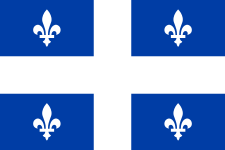몬트리올 과 퀘벡 의 대기질 데이터는 한동안 제공되었지만 최근 캐나다의 이 지역에서 사용되는 AQI 척도에 대한 질문이 거의 없습니다. 그중 하나는 Marie A.가 보낸 질문입니다.
귀사 웹사이트의 대기질 지수가 몬트리올 웹사이트의 AQI와 왜 다른지 알고 싶습니다. US EPA AQI 표준을 충족하기 위해 다시 계산하는 것이 있나요? 그렇다면 어떻게? 어떤 데이터로?
예를 들어 날짜가 7월 14일 오후 2시라면 웹사이트 에 있는 대부분의 지수는 53~65(한 지수는 37)이며 실시간 AQI로 간주됩니다. 7월 14일 오후 2시 몬트리올 시 웹사이트에서 대부분의 지수는 16~37이며 실시간 AQI도 마찬가지입니다.
그렇다면 차이점과 사용 중인 표준 세부 사항이 무엇인지 설명해 주시겠습니까?
이것은 정말 좋은 질문입니다. 이 글에서는 사용 중인 다양한 스케일, 스케일을 서로 비교하는 방법, 변환이 수행되는 방법을 설명합니다.
oOo
이전 기사 중 하나에서 설명했듯이 세계 대기 질 지수 프로젝트에 게시된 모든 AQI 수치는 현재 [1] US EPA 표준을 사용하고 있습니다. 몬트리올이나 퀘벡 모두 이 규칙을 기대하지 않으므로 도시/몬트리올 페이지에 표시된 값이 US EPA 표준을 사용하고 있음을 확인합니다.
이것이 세계 대기질 지수(World Air Quality Index) 프로젝트 수치와 몬트리올 시 웹사이트( montreal.qc.ca ) 사이의 차이가 발생하는 이유입니다. 몬트리올 시 EPA(환경 보호국)는 고유한 적절한 AQI 척도를 사용하고 있으며 이는 다음 페이지에 명확하게 설명되어 있습니다. 같은 웹사이트. 약간 더 "복잡하게" 만들기 위해 퀘벡은 실제로 몬트리올(tabarnac!)과 비교하여 다른 AQI 척도( 이 링크에 지정됨 )를 사용하고 있습니다. 물론 캐나다는 대기 질 건강 지수에 대해 AQHI라는 또 다른 척도를 사용하고 있습니다. 하지만 이는 우리가 이미 다른 기사 에서 쓴 내용입니다.
몬트리올 및 퀘벡 AQI 중단점 요약이 다음 표에 나열되어 있습니다.
| Pollutant | Quebec | Montreal | ||
|---|---|---|---|---|
| Averaging Period | Reference Value | Averaging Period | Reference Value | |
| Fine Particles (PM2.5) | 3 hours | 35µg/m3 | 3 hours | 35µg/m3 |
| Ozone (O3) | 1 hour | 82 ppb | 1 hour | 160 µg/m3 |
| Nitrogen dioxide (NO2) | 1 hour | 213 ppb | 1 hour | 400 µg/m3 |
| Sulfur dioxide (SO2) | 4 minutes mobile | 213 ppb | 10 minutes mobile | 500 µg/m3 |
| Carbon monoxide (CO) | 1 hour | 30 ppm | 1 hour | 35 µg/m3 |
oOo
값을 US EPA 표준으로 변환하려면 밀리그램 또는 ppb/ppm (10억/100만 개당 입자 수)으로 표시되는 원시 농도가 필요합니다.
불행하게도 몬트리올이나 퀘벡 카운티 모두 이러한 원시 농도를 제공하지 않습니다. 대신 그들은 이미 각각의 AQI 척도로 변환된 대기 질 측정값만 제공하고 있습니다. 그러나 이는 실제로 문제가 되지 않습니다. 왜냐하면 농도로의 재변환은 다음과 같은 간단한 선형 공식을 사용하여 수행할 수 있기 때문입니다.
Raw concentration (pollutant) = Reference value (pollutant) * AQI }(pollutant) / 50예를 들어 PM 2.5 AQI 값 18이 몬트리올 시 웹사이트에 게시된 경우 밀리그램 단위의 원시 농도는 18*35/50 = 12.6mg/m3입니다. 오존, CO, SO 2 및 NO 2 의 경우 퀘벡과 몬트리올의 단위가 서로 다르지만(퀘벡 - 미국 표준의 경우 ppb, 몬트리올 EU 표준의 경우 mg) 이는 단지 추가 변환일 뿐입니다(이 기사 에서 부분적으로 설명됨). .
PM 2.5 AQI는 3시간 평균을 기준으로 하는 반면, 세계 대기 질 지수(World Air Quality Index) 프로젝트에서는 시간별 PM 2.5 Instant Cast AQI 보고가 사용됩니다. 3시간 평균에서 시간별 데이터를 공제하는 것이 불가능하기 때문에 이는 실제로 몬트리올과 퀘벡의 세계 대기 질 지수 프로젝트에 보고된 PM 2.5 AQI가 정확히 "인스턴트 캐스트" 보고가 아님을 의미합니다.
oOo
마지막으로 PM 2.5 와 오존에 대한 3가지 AQI 척도(미국 EPA, 퀘벡, 몬트리올)를 시각적으로 비교한 내용이 나와 있습니다(오존의 경우에는ppm 단위가 사용되므로 몬트리올에서는 mg에서ppm으로 변환됩니다). .
주목해야 할 흥미로운 점 중 하나는 퀘벡과 몬트리올 모두 AQI 값 25를 좋음(녹색)과 허용 가능(노란색) 사이의 중단점으로 사용하고 있는 반면, 미국 EPA의 경우 이 중단점은 50으로 설정되어 있다는 것입니다. , 올바른 변환 및 중단점을 염두에 두고 사과 대 사과를 비교할 때 보고된 AQI 범위는 미국 EPA 표준과 퀘벡/몬트리올 표준 간에 매우 유사합니다.
--

